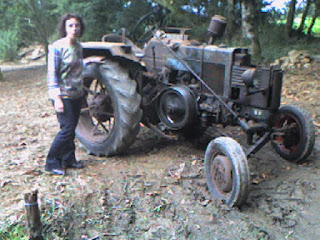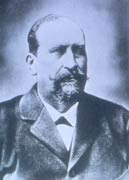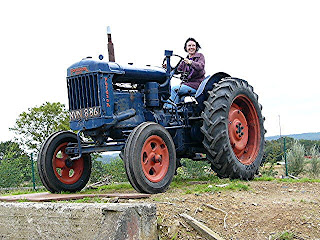
In April 2005 a group of interested people got together to try to save the already closed agricultural museum at Saint Segal, some 10 km from here.
The problem with this project was "Too Many Cooks"!
The majority of the exhibits were owned by Gaby Aven the ex-mayor of the village, the land and buildings were owned by the "Conseil Général du Finistère" (the County Council), the ex-director was not of a mechanical or agricultural bent, but very interested in books and literature, the mayor was all for re-opening but with a view to using the museum for other cultural uses as well. The "Parc Naturel d'Armorique" who finance and help run such projects found that an Agricultural Museum did not really come within their remit, even though they had been involved for a number of years whilst the museum was running.
Last of all we were there, a few restoration enthusiasts, Noel Blin who has a good collection of tractors and agricultural machines himself, Nicolas Yann the grandson of Gaby, the owner of the machines and myself.
So we got around the table several times but somehow there did not seem to be any cohesion betwen the various actors and in July 2005 the whole project was left to die.
We three enthusiasts had seen the writing on the wall.
Noel had said "IF" it folds up could I have 1st refusal on a couple of tractors, especially the "Germinal" made in Austria, 4 wheel drive, single cylinder diesel.
For myself I had for some reason unknown to myself fallen in love with a little Lanz half under an overhanging roof, half outside. The reserves were made, no prices at this stage.
As seen at the museum
Several weeks later Nicolas phoned and said that the Lanz was mine if we could come to a price agreement. I could not wait to get there to organise having this wonderful machine at home!
Next day I went to the museum, climbed over the fence and took some photos, had a real good look and found that the majority of the machine was there, rusty, but there, if I remember rightly, I think it even turned over even though the chimney was open to the elements. After some haggling with Nic, we came to an agreement and after a little time the Lanz 5506 was loaded onto the tipping trailer behind the Landrover Defender on it's way back home.
For a few days it got a severe coat of looking at, prodding probing and searching on the internet for more information. At the time it seemed too much to take in. Such a change from ordinary 4 cylinder upright engines, conventional, easy to work on and understand.
Cylinder of about three litres on it's side, just one piston, no valves, massive crankshaft like a steam engine, a complicated system to govern the engine's speed, no oil bath, but a total loss system with some of the used oil being recovered and re-introduced into the clean oil to be used again! A cluch that has no disk, but three massive weighted levers with a V covered in Ferodo which engages in a V slot in one of the flywheels. This machine is something that will never catch on!
However little by little I started to become more familiar with the tractor and it's workings, took off the chimney to see the exhaust port (and how much it was chammed up with carbon) to find that there was absolutely no compression at all, half the diesel fittings had been robbed, that the radiator just held water, that is if you had a watercan at the ready to fill up regularly. The stater motor did not work at all. This is a hellishly complicated piece of machinery, it doesn't turn the engine over TDC, it changes rotation using a number of coils and contact breakers when it comes up on compression hence putting a new charge of air in the cylinder for the diesel to explode in and start up.
The exhaust port discovered a bit clogged up, piston and ring just visible
I somehow felt that the motor needed to be turned over again and again to get things moving around and perhaps even loosen the piston rings so we can have some compression. The only tractor that we had at the time with a pulley take-off was the little Cub "Baby" that had been finished restoration that summer and had yet to be shown at Plouigneau with the potato Planter.
A small flat belt not really long enough was all I could come up with but the result was phenominal! The oil had been changed the oil drains on the bottom of the crankcase and the air transfer port had been cleaned out to be sure that there would be no buildup of oil to let the engine run away with itself burning oil till it burst into many pieces.
Yes all was working so with a bit of inginuity, the Cub started turning the Lanz over at about 500RPM. As the engine runs between 350 and 900 revs when working, this seemed to be about right. After a short while oil started splurting out of the exhaust port with the compressed air. I should say here that I didn't have any diesel connected up, it was just turning over light to clear the cobwebs out.
Baby powering the Lanz.
3/4 hour and that was enough, compression had been found, oil was getting round the system so some good had been done. Have some lunch and see what can be done with a bit of diesel?
To start the engine this type of Lanz Bulldog one has two choices. There is a system where one starts on petrol with a sparkplug that is energised with a coil and vibrating contact breaker giving a constant spark, quite efficient. Or one has what is called a "Hot Bulb" a hollow teardrop shaped liece of manganese steel that runs a very dull red all the time and which forms part of the combustion chamber for the injector to spray directly onto the hot metal inside. Until this bulb is hot the diesel will not combust. Do not forget that up till 1952/3 all Lanz engines were SEMI diesel, that is to say low compression, there is not enough compression to heat the air enough to explode the vapourised diesel The hot bulb is ideal. So an external heat source has to be applied. This is in the form of a blowtorch of some sort, originally it was a parafin or petrol torch, but now we find it easier to have a bottle of LPG gas and a blowtorch.
Heated up the bulb to dull red, ensured fuel was getting to the injector, grasped the left hand of the two flywheels which hass a special ridged flange for hand starting.
Never having started a Lanz before the learning curve was almost vertical, which way does one pull, I knew that the engine rotated towards the back of the tractor, that is clockwise on this side, so I tried pulling in that direction, then the other then from one compression to the other, after about 5 minutes I got a pop from the exhaust port (no chimney) so I tried what I thought that I had just done again and YES sparks, oil and exhaust came out and wonders of wonders the Lanz was running! Now it's getting hot don't forget to top the water up, is there enough oil, don't panic!
So half an hour running, I thought, well that's ok, but the thing is designed to more than to stand around spitting oil at me. Gingerly I engaged the clutch and put it in reverse, and it moved under it's own power after 22 years of standing around, I even took it up a little farm track next to the house, which is quite steep, encouragingly it went up in 1st, came back down and as it was nearly the time Noëlle comes back from work, I left it running for her to see, back wheels in a trench as there were no brakes to talk of. NoNo arrived not believing her eyes, so pleased and happy for the tractor, me and us!
That is just the beginning
Pat










